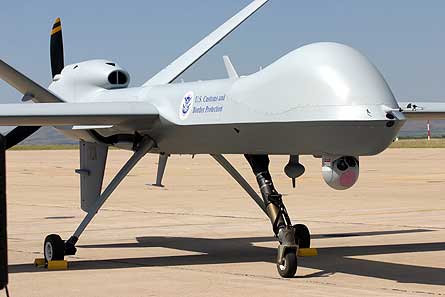©©US Customs and Border Protection (USCBP) will commence a UAV surveillance programme along the Canadian border in August-September this year using a single General Atomics Aeronautical Systems (GA-ASI) Predator B aircraft.
In parallel new Ku-band satellite communications ground infrastructure will be developed at the USCBP’s existing air and marine operations centre at Riverside, California, at an estimated cost of $105 million to allow improved co-ordination of UAVs operated by the service within the US national airspace.
That new infrastructure will support existing Predator B surveillance operations along the US-Mexican border as well as the new northern programme.
USCBP UAVs used on the Canadian border will operate out of existing US National Guard facilities at Grand Forks in North Dakota.
In a USCBP statement released 8 January, Michael Kostelnik, assistant commissioner USCBP Air and Marine says that as “unmanned aircraft have proven to be effective on our southern border, this first step in North Dakota will lay the foundation to expand unmanned aircraft system (UAS) operations along the nation's northern border. As CBP expands air operations along the northern tier, the presence of the UAS will further enhance our situational awareness.”
USCBP anticipates having four Predator Bs in operation by September this year. The sole existing aircraft, part of a two-UAV order, was delivered in late September 2006 and commenced operations in early October (pictured below). The initial aircraft was delivered in September 2005 but was lost seven months later due to operator error. GA-ASI confirms discussions are continuing on replacement arrangements: “[US]CBP is still negotiating the settlement with us,” it says.
|
|
|---|
The agency placed a $33.9 million order for its third and forth Predator Bs on 9 October with the first of these to be delivered just ahead of the commencement of the Canadian pilot project.
The agency is also exploring a third order to support expansion of surveillance operations to include the Caribbean region as well as provide additional aircraft for existing operations. The US Congress plans to provide USCBP with a dedicated $10 million annual funding line for UAV operations on a recurring basis.
USCBP and the US National Guard have been in discussions about roles for the Grand Forks base since early 2006. This includes consideration of options for a partnering arrangement under which Guard personnel would directly support USCBP Predator Bs performing the northern border mission. GA-ASI says that it is not a party to those talks, but confirms that it is in discussion with USCBP on the operation of its existing logistics support contracts with the USAF.
All current USCBP Predator B border surveillance operations are carried out using GA-ASI pilots and sensor operators. However the agency is looking to commence training its own crews once UAV operations are normalised as part of its command and control systems.
Grand Forks is separately being assessed by the US Air Force as the focus for a new UAV flight training centre, potentially including basic operator training for crews for its Northrop Grumman RQ-4B Global Hawk aircraft prior to commencement of advanced training at Beale Air Force base in California. Northrop Grumman is known to be participating in three way talks involving the USAF, the US National Guard, and North Dakota government authorities on the possible initiative.
Source: FlightGlobal.com

















